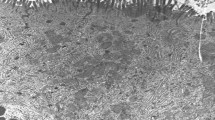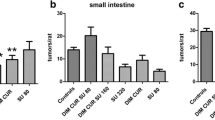Abstract
Seaweeds are rich sources of dietary fiber which possess diverse physiological functions in the colon. In the present study, the modulating effect of feeding seatangle (Laminaria japonica), a fiber-rich seaweed, on initiation and postinitiation of rat colon carcinogenesis was investigated. Four groups of animals were exposed to two weekly injections of a chemical carcinogen azoxymethane (AOM). Animals were fed a fiber-free semisynthetic diet or a diet containing 15% seatangle (4.7 g dietary fiber/100 g diet) during initiation, postinitiation or initiation postinitiation phase of carcinogenesis. Study results showed that animals fed the seatangle-containing diet had a significantly decreased number of both aberrant crypts and aberrant crypt foci in the colon. Also, labeling indices and proliferation zones were signi- ficantly reduced in the colon of the rats fed a seatangle diet. All of the seatangle feeding regimens used in this study were effective in reducing aberrant crypt formation indicating anticarcinogenic effects are mediated through both the blocking of initiation and the suppression of cell proliferation in initiated cells. These results suggest that a diet containing seatangle may decrease the risk of developing colon cancer although the precise cellular mechanisms involved in anticarcinogenic effects of seatangle should be further examined.
Similar content being viewed by others
References
Steinmetz KA, Potter JD (1990) Vegetables, fruit, and cancer. I. Epidemiology. Cancer Causes Contr 2: 325–357.
Block G, Patterson B, Subar A (1991) Fruit, vegetables, and cancer prevention: A review of the epidemiological evidence. Nutr Cancer 18: 1–19.
Johnson IT, Wiliamson G, Musk SRR (1994) Anticarcinogenic factors in plant foods: A new class of nutrients? Nutr Res Rev 7: 175–204.
Suzuki T, Ohsugi Y, Yoshie Y, Shirai T, Hirano T (1996) Dietary fiber content, water-holding capacity and binding capacity of seaweeds. Fish Sci 62: 454–461.
Han KH, Lee EJ, Sung MK (1999) Physical characteristics and antioxidative capacity of major seaweeds. J Food Sci Nutr 4: 180–183.
Okai Y, Higashi-Okai K, Nakamura S (1993) Identification of heterogenous antimuta-genic activities in the extract of edible seaweeds Laminaria japonica (Makonabu) and Undaria pinnatifida (Wakame) by umu gene expression system in Salmonella typhimurium (TA1535/pSK 1002). Mutat Res 303: 63–70.
Yamamoto I, Takahashi M, Tamura E, Maruyama H, Mori H (1984) Antitumor activity of edible marine algae: effect of crude fucoidan fractions prepared from edible brown seaweeds against L-1210 leukemia. Hydrobiologia 116: 145–150.
Yamamoto I, Nagumo T, Takahashi M, Fujihara M, Suzuki Y, Iizima N (1981) Antitumor effect of seaweeds: III. Antitumor effect of an extract from Sargassum kjellmanianum. Jpn J Exp Med 51: 187–189.
Bird RP (1995) Role of aberrant crypt foci in understanding the pathogenesis of colon cancer. Cancer Lett 93: 55–71.
Shpitz B, Hay K, Medline A, Bruce WR, Virona A, Gallinger S, Bull S, Stern H (1993) Aberrant crypt foci: Early markers of malignancy in rat colon carcinogenesis. Assoc Proc Amer Cancer Res 34: 115.
Alabaster O, Tang Z, Shivapurkar N (1996) Dietary fiber and the chemopreventive modulation of colon carcinogenesis. Mutat Res 350: 185–197.
Shivapurkar N, Huang L, Ruggeri B, Swalsky PA, Bakker A, Finkelstein S, Frost A, Silverberg S (1997) K-ras and p53 mutations in aberrant crypt foci and colonic tumors from colon cancer patients. Cancer Lett 115: 39–46.
Lipkin M, Higgins P (1988) Biological markers of cell proliferation and differentiation in human gastrointestinal diseases. In: Klein G, Weinhouse S (eds), Advances in Cancer Research, Vol. 50. Academic Press, pp 1–24.
Stadler J, Yeung KS, Furrer R, Marcon N, Himal HS, Bruce WR (1988) Proliferative activity of rectal mucosa and soluble fecal bile acids in patients with normal colons and in patients with colonic polyps or cancer. Cancer Lett 38: 315–320.
Wattenberg L (1993) Chemoprevention of carcinogenesis by minor non-nutrient con-stituents of the diet. In: Parke DV, Ioannides C, Walker R (eds), Food, Nutrition and Chemical Toxicity. London/Niigata: Smith-Gordon Co., Ltd./Nishimura Co. Ltd., pp 287–300.
Slaga TJ (1984) Mechanisms involved in two-stage carcinogenesis in mouse skin. In: Mechanisms of Tumor Promotion. Boca Raton, FL: CRC Press, pp 1–93.
Reddy BS (1999) Role of dietary fiber in colon cancer: An overview. AmJ Med 106(1A): 16S–19S.
Souci SW, Fachmann W, Kraut H (1994) Food Composition and Nutrition Tables. Boca Raton, FL: CRC Press, p 569.
Author information
Authors and Affiliations
Rights and permissions
About this article
Cite this article
Lee, EJ., Sung, MK. Chemoprevention of azoxymethane-induced rat colon carcinogenesis by seatangle, a fiber-rich seaweed. Plant Foods Hum Nutr 58, 1–8 (2003). https://doi.org/10.1023/B:QUAL.0000040307.57930.a4
Issue Date:
DOI: https://doi.org/10.1023/B:QUAL.0000040307.57930.a4




